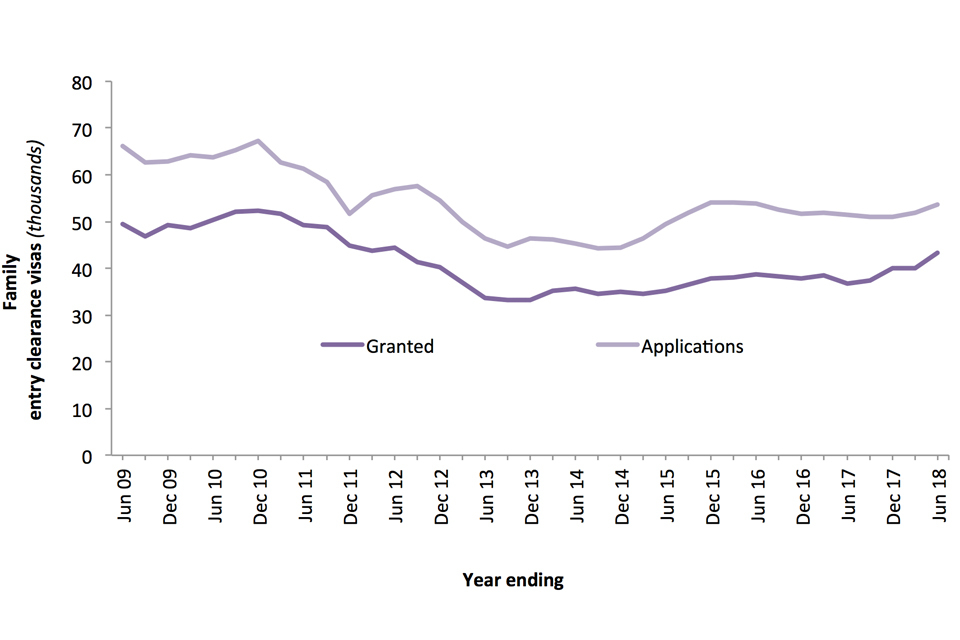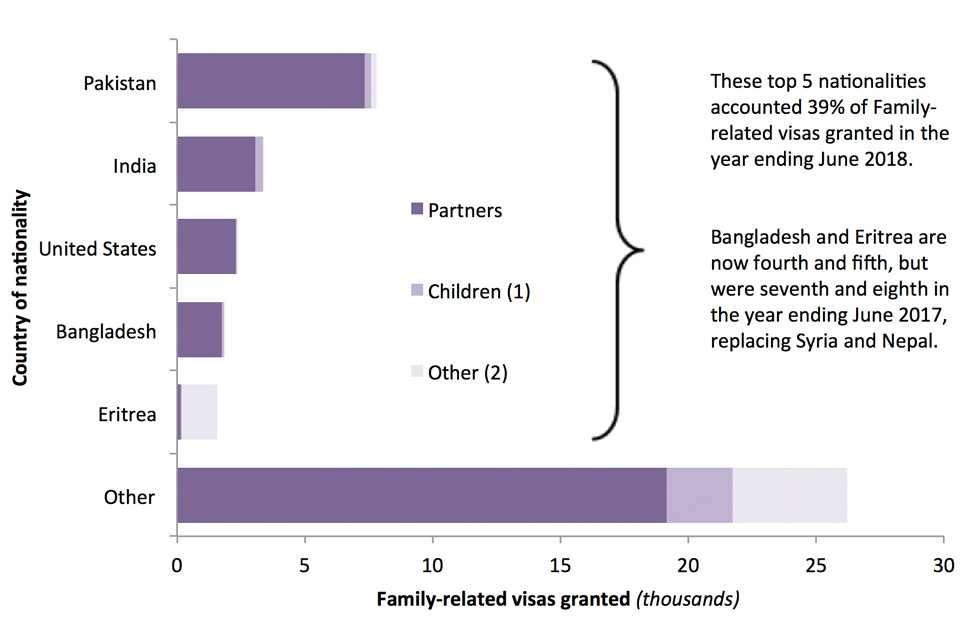Why do people come to the UK? (4) For family reasons
Published 23 August 2018
We welcome your feedback
The content and format of the quarterly release and associated data tables is currently being reviewed. This means the release may be subject to change in the future. If you have any comments, or suggestions for the development of this report, please provide feedback by emailing MigrationStatsEnquiries@homeoffice.gov.uk. Please include the words ‘PUBLICATION FEEDBACK’ in the subject of your email.
The Home Office is also running a more general survey on Home Office statistical publications, which covers all Home Office statistical publications.
See section 6 of the About this release section for more details.
Back to ‘Immigration statistics, year ending June 2018’ content page.
This is not the latest release. View latest release.
Data relate to the year ending June 2018 and all comparisons are with the year ending June 2017, unless indicated otherwise.
This section contains data on:
- family-related Entry clearance visas
- dependants on other visas (excluding visitor visas)
- EEA Family permits
For figures on family-related grants of settlement as well as residence documentation issued to EEA nationals and their family members see ‘How many people continue their stay in the UK?’. Data on the Family reunion visa category can be found in this edition’s ‘How many people do we grant asylum or protection to?’ section.
1. Key facts
There were 141,416 visas granted for family reasons in the year ending June 2018, 9% more than in the previous year. This included:
- 43,228 family-related visas, up 18%
- 68,726 dependants of people coming to the UK on other visas (excluding Visitor visas), up 7%
- 29,462 EEA Family permits, no change from the previous year
2. Trends in immigration for family reasons
2.1 Immigration for family reasons by type of visa
Family-related visas and EEA family permits granted, by visa type, year ending June 2018 compared to the year ending June 2017
| Year ending | June 2017 | June 2018 | Change | Percentage change |
|---|---|---|---|---|
| Family-related visas granted | 36,710 | 43,228 | +6,518 | +18% |
| of which: | ||||
| Partners | 28,896 | 33,739 | +4,843 | +17% |
| Children1 | 2,168 | 3,291 | +1,123 | +52% |
| Other dependants | 5,646 | 6,198 | +552 | +10% |
| Dependants on other visas (excl. Visitor visas) | 64,002 | 68,726 | +4,724 | +7% |
| EEA Family permits granted | 29,438 | 29,462 | +24 | 0% |
| Total | 130,150 | 141,416 | +11,266 | +9% |
Source:
Table vi 01 q, (Entry clearance visas tables, volume 1)
Table note:
- Family-related visas issued to children do not include children of a parent given limited leave to enter or remain in the UK for a probationary period prior to December 2017. These were included as ‘Dependants on other visas (excl. Visitor visas)’. The increase in grants to children in the year ending June 2018 reflects this change.
2.2 Long-term trends in immigration for family reasons
Family-related visas and EEA Family permits granted1, year ending June 2009 to the year ending June 20182,3

The chart shows the number of family-related visas (including dependants on other visas), and EEA Family permits granted over the last 10 years.
Source:
Table vi 04 q, (Entry clearance visas tables, volume 1)
Chart notes:
- Includes dependants of those coming on other visa categories (such as Work and Study), but excludes visitors.
- From 29 November 2010, all non-EEA nationals applying to enter or extend their stay as a partner of a British citizen or settled person were required to demonstrate a level of English, except in certain circumstances.
- A number of changes to the Immigration Rules came into effect on 9 July 2012. Further details can be found in the user guide.
3. Family-related visas
3.1 Family-related visa outcomes
There were 43,228 family-related visas granted in the year ending June 2018, a similar level to the year ending June 2012. This number does not include dependants of other migrants who are discussed in section 4.
On 9 July 2012, a number of changes to the Immigration Rules came into effect. Although the number of family-related visas granted was falling prior to this period, this change led to further falls. However, the number of grants has increased in recent years compared with the year ending June 2014. For further information on the rule changes see the Family section of the user guide.
Additional analysis on Family visas was included in the Immigration Statistics July to September 2014 release, to assist users in understanding the trends in family data before and after the changes to the Immigration Rules in July 2012 (updated in the Immigration Statistics April to June 2015 release).
Family-related visa applications and grants1, year ending June 2009 to the year ending June 2018

The chart shows the number of family-related visa applications and grants over the last 10 years.
Source:
Table vi 01 q, (Entry clearance visas tables, volume 1)
Chart note:
- Grants are based on date of decision and do not necessarily relate to applications made in the same period; for example, a grant in 2017 may relate to an application made in 2016.
The grant rate in the year ending June 2018 was 75%. This was similar to the previous year, but higher than the years ending June 2015 and 2016 (65% and 67% respectively). Grant and refusals rates will have been affected by applications that were put on a temporary hold. For further information see the Family section of the user guide.
3.2 Family-related visas by nationality
Nationals of Pakistan were issued with the highest number of family-related visas in the year ending June 2018. The top 5 nationalities accounted for almost two-fifths (39%) of family-related visas granted.
Family-related visas granted1,2, by nationality (top 5), year ending June 2018

The chart shows the number of family-related visas granted to each of the top 5 nationalities in the year ending June 2018.
Source:
Table vi 06 q f, (Entry clearance visas tables, volume 3)
Chart notes:
- From December 2017, this category includes: children of a parent given limited leave to enter or remain in the UK for a probationary period. Prior to December 2017, they were included in Dependants joining/accompanying: child using the same visa endorsement as children joining/accompanying migrants in other routes.
- Includes Family reunion cases (pre-existing partners and minor children of persons granted refugee status or humanitarian protection). The relatively high numbers for Eritrean nationals (nearly one-quarter (23%) of all ‘Other’ cases) reflects large numbers of Family reunion cases for that nationality.
There were notable increases in the number of Family visas granted to:
- Pakistani nationals, up 1,662 (27%) to 7,818. This continues the trend of year-on-year increases since the year ending June 2014
- Indian nationals, up 672 (25%) to 3,383, a return to the level seen in the year ending June 2016
There was a notable decrease in the number of Family visas granted to:
- Syrian nationals, down 1,013 (57%) to 769, reflecting a decrease in the number of family reunion applications by Syrian nationals
4. Dependants on other visas (excluding Visitor visas)
In addition to a Family visa, other dependants of non-family-related visas can be granted a visa to join or accompany migrants who have been granted the right to enter the UK for other purposes, such as to work or to study.
In the year ending June 2018, 68,726 visas were granted to dependants on other visas (excluding visitors), an increase of 7% compared with the previous 12 months (64,002) and 36% lower than the peak of 106,723 in the year ending March 2007.
Of the 68,726 visas granted:
- 70% were to dependants of workers (48,299)
- 18% were to dependants of students (12,213)
- 12% were to other dependants accompanying or joining a migrant already in the UK (8,214)
5. EEA Family permits
An individual can apply for an EEA Family permit to come to the UK if they’re both:
- from outside the EEA and,
- applying as the family member or ‘extended’ family member of an EEA or Swiss national (excluding UK nationals)
In the year ending June 2018, there were 29,462 EEA Family permits granted to non-EEA family members of EEA nationals.
EEA Family permits granted, by nationality (top 5), year ending June 2018

The chart shows the number of EEA Family permits granted to each of the top 5 nationalities in the year ending June 2018.
Source:
Table vi 06 q o, (Entry clearance visas tables, volume 3)
6. Data tables
Data on family immigration can be found in the following tables:
Visas tables volume 1
Visas tables volume 2
Visas tables volume 3
Admissions tables
Extensions tables
Settlement tables
